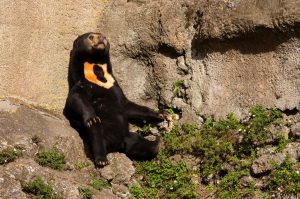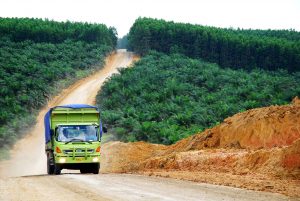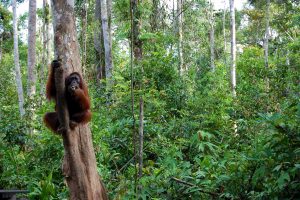With his charm, charisma and infectious enthusiasm for big band jazz, it was the Jungle Book’s King Louie who first introduced many of us to the rainforests of Southeast Asia. But beyond now sounding an awful lot like Christopher Walken, what’s happened to the old Orang-utan over the last 50 years?
Unfortunately, there’s little to report in the way of good news. Despite our affections, Orang-utans, along with much of their rainforest ecosystem, are struggling to survive. Mowgli, as it turns out, grew up…and in doing so, discovered that selling oil derived from palm nuts is a quick and easy means of turning a profit (McCarthy et al., 2012).

As a result, the production of palm oil has become big business throughout the developing world, but particularly in Southeast Asia (Koh and Wilcove, 2007). The implications for rainforest ecosystems however, are dire. In order to produce palm oil, vast areas of rainforest must be cleared to make way for plantations of oil palms.
Such a widespread loss of habitat poses an obvious threat to iconic species such as the Orang-utan who depend on the rainforest for survival. However, the problem of palm oil may run deeper.


Image credit: (left) Tambako via Flickr, (right) Disney
The emerging field of complexity science suggests additional concerns in that we should consider also the nature of deforestation patterns and the effect this has on the capacity of rainforests to recover from stress. Only then, can we hope to effectively conserve rainforest ecosystems.
Unsurprisingly, deforestation occurs largely along the fringes of roads. However, this results in not only habitat loss, but also habitat fragmentation. In isolating patches of rainforest within traffic laden road networks, organisms become trapped. Reducing the connectivity of an ecosystem in this way can in turn undermine its resilience (Pardini et al., 2010); that is, its ability to respond and recover from stress events.
For example, if a fire were to break out in an isolated forest surrounded by roads, mammal species may find it difficult to escape and would therefore perish. Furthermore, without the movement of organisms to transport seeds, some plant species could encounter difficulty recolonising the area once the flames have subsided.
It is worth noting that the barriers between isolated rainforest stands expand from busy roads to entire palm oil plantations spanning hundreds of square kilometres. When we consider that the plantations themselves can form barriers to even some bird species (Knowlton et al., 2017), the need for an urgent and effective solution becomes clear.

Alongside traditional restoration methods, the development of forest corridors may provide the answer (Sodhi et al., 2010), with similar projects having achieved success elsewhere in the world (Wyborn, 2011). In providing a means for organisms to travel between detached rainforest patches, ecosystem managers can enhance the resilience of the habitat and help to ensure its continued survival.
However, effective implementation must be swift. Else we run the risk of losing King Louie and his jungle kingdom, forever.
Click here more info on how ecosystems can be managed to improve their resilience.

Image credit: CIFOR via Flickr
Word count: 500
References:
Fredriksson, G., Steinmetz, R., Wong, S. and Garshelis, D.L. (IUCN SSC Bear Specialist Group) (2008) Helarctos malayanus. The IUCN Red List of Threatened Species 2008. Available from: http://dx.doi.org/10.2305/IUCN.UK.2008.RLTS.T9760A13014055.en. [Accessed 14 March 2017].
Hance, J. (2016) Another big predator in Southeast Asia faces extinction. The Guardian, 31 August. Available from: https://www.theguardian.com/environment/radical-conservation/2016/aug/31/leopards-tigers-asia-snares-poaching-endangered-extinction [Accessed 14 March 2017].
Knowlton, J.L., Phifer, C.C., Cerqueira, P.V., Barro, F.D.C., Oliveira, S.L., Fiser, C.M., Becker, N.M., Cardoso, M.R., Flaspohler, D.J. and Dantas Santos, M.P. (2017) Oil palm plantations affect movement behavior of a key member of mixed-species flocks of forest birds in Amazonia, Brazil.Tropical Conservation Science, 10, 1-10.
Koh, L.P. and Wilcove, D.S. (2007) Cashing in palm oil for conservation. Nature, 448 (7517), 993-994.
McCarthy, J.F., Gillespie, P. and Zen, Z. (2012) Swimming upstream: Local Indonesian production networks in “globalized” palm oil production.World Development, 40 (3), 555-569.
Pardini, R., Bueno, A.dA., Gardner, T.A., Prado, P.I. and Metzger, J.P. (2010) Beyond the fragmentation threshold hypothesis: regime shifts in biodiversity across fragmented landscapes.PloS one, 5 (10), e13666.
Sodhi, N.S., Koh, L.P., Clements, R., Wanger, T.C., Hill, J.K., Hamer, K.C., Clough, Y., Tscharntke, T., Posa, M.R.C. and Lee, T.M. (2010) Conserving Southeast Asian forest biodiversity in human-modified landscapes.Biological Conservation, 143 (10), 2375-2384.
Vijay, V., Pimm, S.L., Jenkins, C.N. and Smith, S.J. (2016) The impacts of oil palm on recent deforestation and biodiversity loss. PLoS One, 11 (7), e0159668.
Wong, W.M., Leader-Williams, N. and Linkie, M. (2015) Managing human-sun bear conflict in Sumatran agroforest systems.Human Ecology, 43 (2), 255-266.
Wyborn, C. (2011) Landscape scale ecological connectivity: Australian survey and rehearsals.Pacific Conservation Biology, 17 (2), 121-131.
Recent Comments